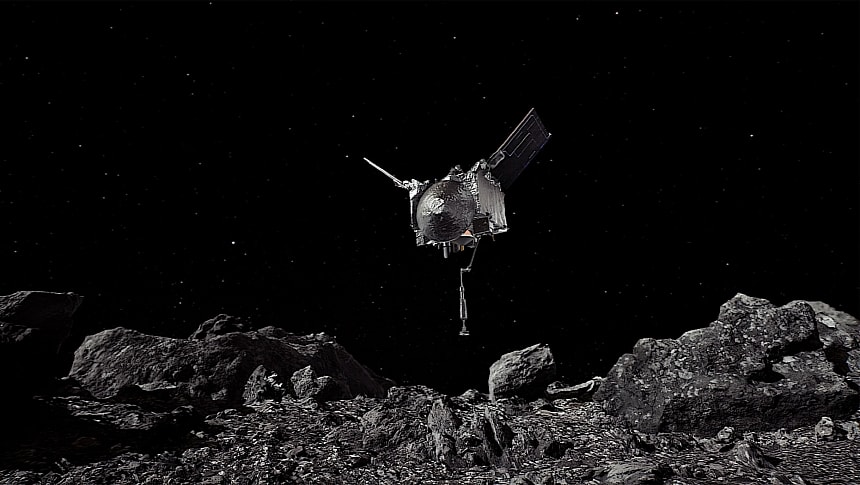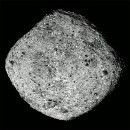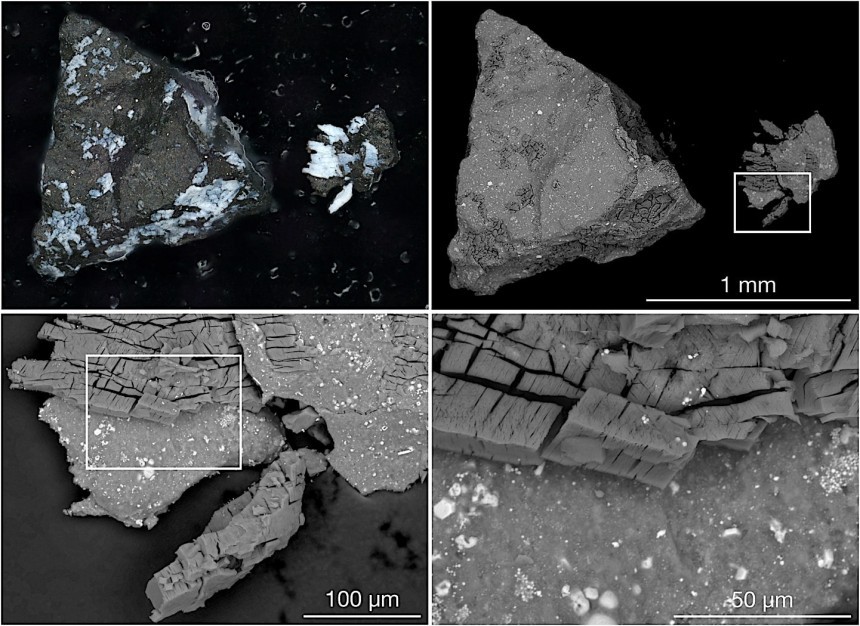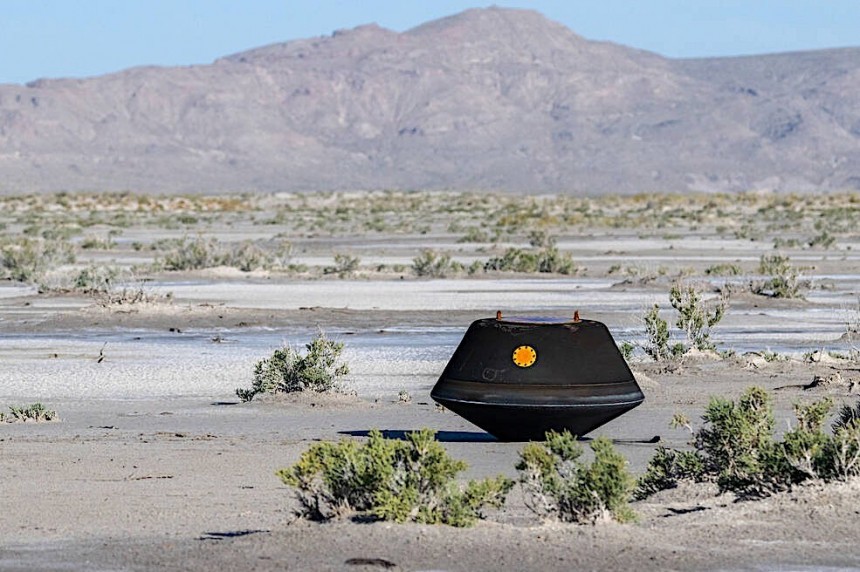It's been a while since America brought back its first-ever samples of an asteroid (the capsule containing the precious material landed in the fall of 2023), and we were about to forget all about it. But last week, NASA stepped up and announced findings so exciting in the samples that they got us all worked up.
The asteroid that was robbed of some of its surface material is called Bennu. It's a carbon-rich piece of rock dating back to the early days of our solar system (meaning it's at least 4.5 billion years old) that may hold important clues not only to how Sol came to be, but also to how life on one of the planets in the system was born.
To study the asteroid, NASA sent a spacecraft Bennu's way back in 2016. It was called Origins, Spectral Interpretation, Resource Identification, and Security-Regolith Explorer (OSIRIS-REx), and its main mission was to sample the asteroid and bring back to Earth small portions of it for study.
The spacecraft did exactly that, and in September last year some 4.3 ounces (121.6 grams) of the place landed in the Utah desert. After being removed from the capsule (not without some issues), the sample landed on scientists' desks, who quickly got to it analyzing what was in there. And now, the first exciting results are in.
Why do I say exciting? Well, scientists were hoping to uncover at least some of the secrets of how life came to be on Earth, and it appears Bennu delivered exactly that: the place "contains the original ingredients that formed our solar system," and even the ingredients of life as we know it.
On June 26 a paper was published in the Meteoritics & Planetary Science online library, and it contains an early analysis of the Bennu samples. The results show that the place is, as expected, rich in carbon and nitrogen, but that it also contains organic compounds that are essential to life as it developed here on Earth.
We're not told exactly what those compounds are, but we are informed of something that's even more extraordinary: the place also has magnesium-sodium phosphate.
Bennu is not the first asteroid to have borrowed us a piece of its body. Back in 2020, a mission of Japanese space agency JAXA called Hayabusa2 brought back samples from another rock called Ryugu. It too contained such a phosphate, but the sample brought back from Bennu surprised through its purity and the size of the grains, "unprecedented in any meteorite sample."
The presence of this element is an indication that Bennu was once part of a small and primitive ocean world that roamed the solar system in times immemorial. It too is a component of the biochemistry that makes life on Earth possible.
Another hint that the place originated from a wet world is the fact that there are clay minerals in the samples. They are similar to what is found on Earth in mid-ocean ridges, where material from the planet's mantle meets water.
"The presence and state of phosphates, along with other elements and compounds on Bennu, suggest a watery past for the asteroid," said in a statement Dante Lauretta from the biochemistry, co-lead author of the paper and principal investigator for OSIRIS-REx.
"Bennu potentially could have once been part of a wetter world. Although, this hypothesis requires further investigation."
Despite all the exciting hints of the ingredients of life being present elsewhere in the solar system, the asteroid remains however a dead piece of rock, with elemental proportions that are closer to that of the Sun than a life-supporting planet.
Now that true research into the samples is ongoing, the pace at which we will receive word of what was discovered is about to accelerate. NASA will send Bennu samples to dozens of more laboratories all over the world, so brace yourself for a wealth of new findings from what is described as the "largest reservoir of unaltered asteroid material on Earth."
As for the spacecraft that sent the capsules with the samples back to Earth, the OSIRIS-REx was repurposed, and it is now en route towards another asteroid, this time a more nefarious one.
The target of the mission is the Apophis asteroid, a piece of space debris that was discovered in 2004 and was initially described as one of the most hazardous of its kind out there. The 1,100 feet (335 meters) chunk of rock was believed to have a non-negligible chance of hitting our planet in 2029 or 2068, but a closer look revealed we should be safe from it for the next century or so.
We're told the closest Apophis will come to Earth is 20,000 miles (32,000 km), and that will happen a year before the end of the decade.
The spacecraft heading its way, now called OSIRIS-APEX (meaning Apophis Explorer), will reach it in 2029. This time it won't land and snatch samples, but spin around it in an orbit that will allow it to map the surface and try to determine its composition from afar.
To study the asteroid, NASA sent a spacecraft Bennu's way back in 2016. It was called Origins, Spectral Interpretation, Resource Identification, and Security-Regolith Explorer (OSIRIS-REx), and its main mission was to sample the asteroid and bring back to Earth small portions of it for study.
The spacecraft did exactly that, and in September last year some 4.3 ounces (121.6 grams) of the place landed in the Utah desert. After being removed from the capsule (not without some issues), the sample landed on scientists' desks, who quickly got to it analyzing what was in there. And now, the first exciting results are in.
Why do I say exciting? Well, scientists were hoping to uncover at least some of the secrets of how life came to be on Earth, and it appears Bennu delivered exactly that: the place "contains the original ingredients that formed our solar system," and even the ingredients of life as we know it.
On June 26 a paper was published in the Meteoritics & Planetary Science online library, and it contains an early analysis of the Bennu samples. The results show that the place is, as expected, rich in carbon and nitrogen, but that it also contains organic compounds that are essential to life as it developed here on Earth.
Bennu is not the first asteroid to have borrowed us a piece of its body. Back in 2020, a mission of Japanese space agency JAXA called Hayabusa2 brought back samples from another rock called Ryugu. It too contained such a phosphate, but the sample brought back from Bennu surprised through its purity and the size of the grains, "unprecedented in any meteorite sample."
The presence of this element is an indication that Bennu was once part of a small and primitive ocean world that roamed the solar system in times immemorial. It too is a component of the biochemistry that makes life on Earth possible.
Another hint that the place originated from a wet world is the fact that there are clay minerals in the samples. They are similar to what is found on Earth in mid-ocean ridges, where material from the planet's mantle meets water.
"The presence and state of phosphates, along with other elements and compounds on Bennu, suggest a watery past for the asteroid," said in a statement Dante Lauretta from the biochemistry, co-lead author of the paper and principal investigator for OSIRIS-REx.
"Bennu potentially could have once been part of a wetter world. Although, this hypothesis requires further investigation."
Despite all the exciting hints of the ingredients of life being present elsewhere in the solar system, the asteroid remains however a dead piece of rock, with elemental proportions that are closer to that of the Sun than a life-supporting planet.
As for the spacecraft that sent the capsules with the samples back to Earth, the OSIRIS-REx was repurposed, and it is now en route towards another asteroid, this time a more nefarious one.
The target of the mission is the Apophis asteroid, a piece of space debris that was discovered in 2004 and was initially described as one of the most hazardous of its kind out there. The 1,100 feet (335 meters) chunk of rock was believed to have a non-negligible chance of hitting our planet in 2029 or 2068, but a closer look revealed we should be safe from it for the next century or so.
We're told the closest Apophis will come to Earth is 20,000 miles (32,000 km), and that will happen a year before the end of the decade.
The spacecraft heading its way, now called OSIRIS-APEX (meaning Apophis Explorer), will reach it in 2029. This time it won't land and snatch samples, but spin around it in an orbit that will allow it to map the surface and try to determine its composition from afar.













